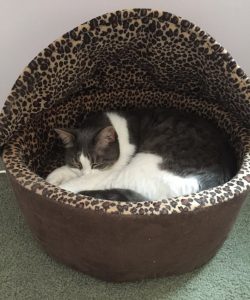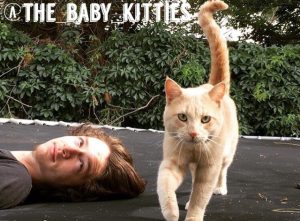Summer may be the favorite season for many, but for horse owners, it can create several challenges. Equines become hot much more quickly than humans do, and the effects can have serious consequences if they aren’t managed correctly.
The horse’s body has evolved over time to cope more easily with cold weather conditions than with the heat. It is, therefore, essential that owners provide the right care for their horses during summer months to keep them in good health.
In this article, we look at four conditions associated with hot weather, how to spot the symptoms, and what action you should take.
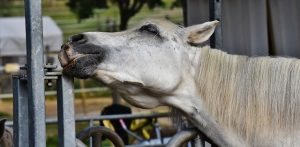
Itchiness is a common symptom seen in several of these conditions.
Anhidrosis
What Is It?
Anhidrosis is a Greek word, which translates to “without sweating.” A horse with this condition is incapable of sweating, and those that suffer from it are also known as non-sweaters, puffers, and dry-coated horses.
What happens is that the sweat glands become over stimulated and then shut down completely. The exact cause is not known, but it is common in horses that have been moved to hot and humid climates.
The condition was first recorded in the 1920s when the British moved their racehorses and polo ponies to colonies such as India and Malaysia and noticed that they didn’t sweat.
Horses, like humans, cool their bodies through sweating. When they are unable to do this, their body temperature remains high, which puts them at risk for heat stroke. It is very dangerous and it can potentially result in death.
It affects horses of any age or breed, whether they are exercised or not, but dark horses tend to be most susceptible.
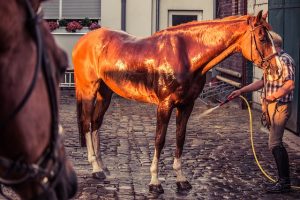
This horse with anhidrosis is getting a cooling rinse-off after exercising.
Symptoms
If your horse suffers from anhidrosis, he will display some or all of the following symptoms:
- Coat that is dry and hot to touch after exercise
- Laboured breathing during and after exercise with flared nostrils
- High temperature
- Increased heart rate
- Lethargy and exhaustion
- Poor coat that is thin and patchy
- Facial hair loss
- Loss of appetite
- Decreased water consumption
What Action to Take
If you think your horse has anhidrosis, your veterinarian will probably do an intradermal terbutaline sweat test. Diagnosing the condition is much easier than controlling it, but it can eventually disappear.
Here are some ways that you can manage a horse with anhidrosis during the summer months:
- Ride when the temperatures are cooler, either early in the morning or late in the evening.
- Take frequent breaks during riding and note how hard your horse is breathing. Watch that he doesn’t overheat.
- Compete at cooler times of the year, as most shows will be held during the daytime in summer.
- After exercise, move him into some shade and cool him down by splashing cold water on his body, neck and legs. Scrape the water off and repeat the process.
- Turn him out during the night.
- During the day, keep him in a well-ventilated barn with fans.
- Ensure fresh water is consistently available.
- Give electrolytes.
If the condition persists and your horse continues to suffer, the only way to cure anhidrosis is to move him to a cooler climate.
Dehydration
What Is It?
Dehydration happens when the loss of fluids from the horse exceeds the fluid intake from food and water.
It is caused by either persistent diarrhea or extreme sweating during strenuous exercise. A horse can lose 10 to 15 liters (nearly 4 gallons) of sweat in one hour, especially when it is hot and humid, and they may struggle to cool down afterwards.
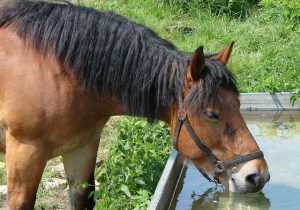
This horse is trying to stay properly hydrated.
As a result, the horse loses vital fluids and electrolytes. Electrolytes perform many functions in your horse’s body and have the same elements as seawater:
- Sodium (Na)
- Magnesium (Mg)
- Calcium (Ca)
- Potassium (K)
- Chloride (Cl)
The danger of dehydration is that sometimes it can be difficult to detect. If left untreated, it can lead to conditions such as colic, kidney failure and azoturia (an abnormal excess of nitrogen compounds in the urine).
Symptoms
To check if your horse is dehydrated, pinch a fold of his skin and then let it go. With a properly hydrated horse, the skin will instantly spring back into place, but if he is dehydrated, it will take a few seconds to return to normal.
Other symptoms include:
- Frequent, shallow breaths
- Sunken eyes
- Lethargy
- Depression
- Gums not pink
- Dry skin and mouth
- Increased heart rate
- Urine dark colored with a powerful odour
- Thick and sticky saliva
- Tucked-up appearance
What Action to Take
Prevention of dehydration is better than a cure.
An average horse’s body contains approximately 70% water, meaning he will usually drink between 5 to 15 gallons of water daily, depending on the amount of exercise they are receiving and the climate.
It is, therefore, vital that clean, fresh water is continuously available.
Adding apple juice or molasses to the water is also a good idea. Once your horse is familiar with the taste, you can add it to the drinking water at shows, as many equines are reluctant to drink when they are away from home.

These guys aren’t at home, but it is crucial for them to have access to water wherever there are.
Ensure that your horse has free access to salt, either loose or via a salt lick, to encourage him to drink and replace lost minerals and electrolytes. Also, many veterinarians now suggest feeding electrolytes daily all year round.
With mild forms of dehydration, offer your horse two buckets of water; one with electrolytes and one plain, allowing him to choose.
Make sure your horse stands in the shade and cool him down by cold hosing. More severe cases will require immediate veterinary treatment, giving fluids via a nasogastric tube.
Sweet Itch
What Is It?
Sweet itch, also known as Pruritus Threshold, is an allergic reaction in horses triggered by the saliva of biting insects, such as midges, lice, black flies and horse flies. Allergies and infections can also be a cause.
With this condition, the horse suffers unbearable and extreme itchiness.
The condition is more common in areas that are prone to bugs, such as ponds, swamps, and bogs and is made worse by hot and humid weather.
A horse suffering from sweet itch, in search of relief, can rub hair completely off the afflicted area, breaking open the skin, which can then become infected.
It affects any part of the horse’s body but is mostly found on the belly, face, back, mane and tail.
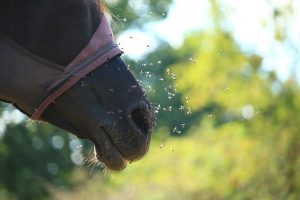
All of these flies would certainly BUG me!
Symptoms
If you think your horse has sweet itch, he will display the following symptoms:
- Mild to severe rubbing
- Loss of mane and tail hair
- Bald patches
- Sections of sore, swollen, open and broken skin which may bleed
What Action to Take
During spring and summer, protect your horse from biting insects by:
- Spraying fly repellent on him
- Use fly masks and sheets
- Stable from 4 pm to 8 am when biting insects are most active
- Use a ceiling fan in his stable
- Do not stable him near woodland or boggy areas
- Cut sweet foods from your horse’s diet
- Add garlic to feed (the smell deters insects!)
When treating sweet itch, it is essential that you consult your veterinarian who can then do a skin scraping to diagnose the cause.
Medication, such as steroids or antibiotics, may be administered along with the appropriate creams, lotions, and shampoos.
Your veterinarian can advise you accordingly as to what is the best cause of action for your horse.
Sunburn
What Is It?
Sunburn, also known as Erythema Solare, is the burning of skin due to over-exposure to UV radiation and it can be extremely painful.
Any horse or pony can get sunburned, but grays, Pintos, Cremellos, Appaloosas, and those with white face and leg markings or pink muzzles, are most susceptible. Foals and yearlings are also particularly prone.

Sometimes you have to protect your horse from the sun’s harmful rays in style!
Symptoms
When an unprotected horse has exposure to the sun for a length of time, he is likely to show the following symptoms:
- Skin that appears red and painful
- Skin is hot and sore to touch
- Skin is dry and cracked
- The skin bleed or be weepy
- Blisters
- Patches of hair loss
- Inflammation
- Peeling of skin
The symptoms of sunburn can lead to dehydration and stress in your horse, caused by the heat and pain, and it may result in colic or liver damage.
Burning rays can damage the skin, cause scarring, and continuous overexposure may lead to skin cancer, squamous cell carcinoma, whereby cancerous growths appear on or around the eyelids.
Treatment
Protect your horse from the sun by:
- Stabling during the day– Keep your horse in a well-ventilated stable during the hottest part of the day. If your horse must be out, ensure that he has proper shade.
- Sunscreen/sunblock– There are many brands that are formulated for horses, or you can use one for humans that are at least 30 SPF. Products containing zinc oxide are particularly useful. Using brightly colored sunscreen is a helpful indication as to when it is wearing off and needs re-applying.
- Protective clothing– There are several sun-blocking fly sheets, fly masks (some with a flap that reaches to the horse’s nose for extra protection), and hoods available on the market now.
If your horse does have sunburn, treat it the same way you would treat your own. Using Aloe Vera sunburn treatments are very soothing and help to heal your horse’s skin. Otherwise, antiseptic ointments such as Sudocream are also good.
If the sunburn does not appear to be healing, contact your veterinarian who may prescribe an antibiotic cream or ointment.
If you have protected your horse against sunburn and he still shows symptoms, there may be individual plants that are causing toxicity and photosensitivity to him. Call your veterinarian who can identify any plants in the area that may cause a sunburn-like reaction.
Also, it is possible that any medication your horse is on may cause the same symptoms and must be investigated by your veterinarian.
By taking these preventative measures, you should be able to keep your horse cool, hydrated, happy and healthy during those long, summer months.

Alison O’Callaghan, our Equine Editor, is a professional horse riding instructor and has owned many types of pets. When she is not riding horses or walking her dog, she loves to write about animals. If you’d like to contact Alison, you can email her at ocallaghan462@gmail.com.


